



VLA Reports increase In Calf Problems
The 2010 annual report for the Veterinary Laboratory Agency (VLA) says that there has been an increase in the annual number of diagnoses of diarrhoea in calves due to rotavirus and cryptosporidiosis.INTRODUCTION
Weather and climateLate November and December were extremely cold and there were sub-zero temperatures and widespread snow-cover across much of GB for several weeks. One consequence of this was the need to feed livestock additional forage and as a result forage supplies on many farms became rapidly depleted. This could have an adverse effect on cattle nutrition this winter, and will also increase the cost of production.
Scanning surveillance submission numbersIn England and Wales in the fourth quarter of 2010 there was a decrease in the total number of diagnostic submissions and of carcases in particular, compared to Q4 of 2008 and 2009 (Figure 1); although there was little observed difference in submissions for 2010 as a whole (Figure 2). The decrease in submissions for Q4 was probably due to three factors:
- Increase in charges to private veterinary surgeons, particularly for necropsies.
- Introduction of a triage procedure to avoid necropsy on submissions where diagnosis could be made by testing of samples.
- Extensive snow in December.
Compared to Q4 of 2009, the reduction in submissions occurred in all regions of GB and in both beef and dairy cattle (Figure 3).
For the year, the number of submissions examined for scanning surveillance was similar to that in 2009. Slightly fewer carcases were necropsied in E&W (for the reasons above) but more were done in Scotland.
Figure 1
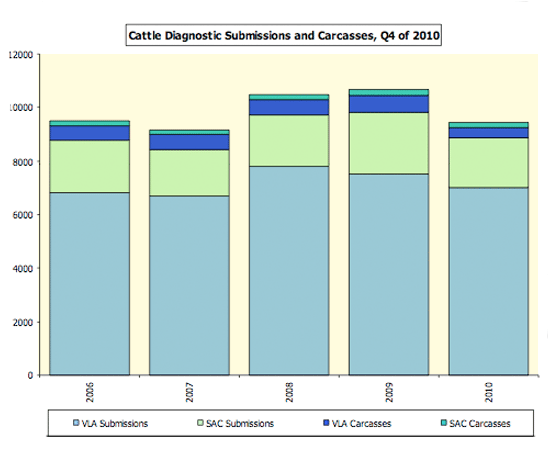
Figure 2
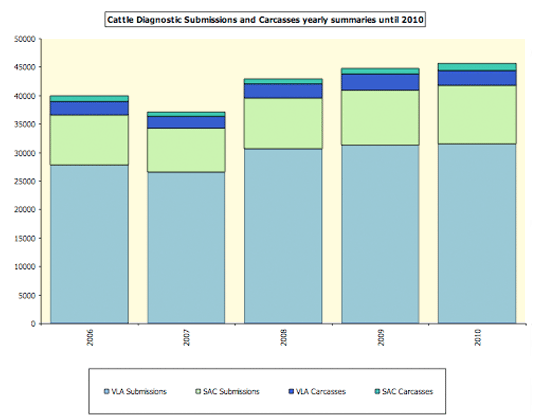
Figure 3
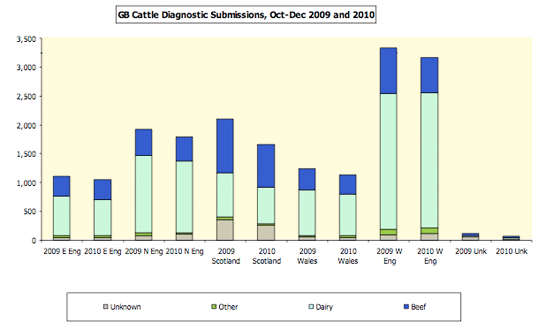
NEW AND EMERGING DISEASES IDENTIFIED IN THE QUARTER
Analysis of Diagnosis Not Reached (DNR) During 2010, 25per cent of cattle submissions in GB were undiagnosed; similar to previous years (26per cent). However, at 23per cent, the per centDNR for the final quarter of 2010 (October – December) was significantly lower than Q4 in previous years (26per cent) and Q3 in 2010 (27per cent).
Conversely, a statistically significant increase in undiagnosed skin cases occurred during Q4 2010. However, given the small number of incidents (n=10) and that these incidents were of many different clinical presentations of skin disease, there was no suggestion of an undiagnosed, emerging skin condition. Monitoring will continue and no further action is warranted.
The increase in undiagnosed enteric disease reported in Q3 2010 did not continue into Q4 and the annual figure for 2010 indicated an overall decrease in undiagnosed enteric disease across the age groups compared to previous years.
Similarly the increase in undiagnosed respiratory disease in English and Welsh cattle observed in September 2010 did not continue into the final quarter of the year (Figure 4). Monitoring will continue with no further action advised at this stage.
Figure 4: Comparison of cases of undiagnosed cases respiratory disease in England and Wales in 2010 with previous years.

ON-GOING NEW AND EMERGING DISEASE INVESTIGATIONS
Metritis in a dairy herd This project was undertaken in a 400 cow dairy herd with a rising incidence of metritis cases manifested by a purulent vaginal discharge in the first three weeks after calving. The purpose of the project was to investigate the potential role of bacteria and viruses (Bovine Herpes Virus-4, BoHV-4 and Bovine Lymphocytic Herpes Virus, BLHV). Fifteen clinically affected and fifteen unaffected animals were selected and sampled by the private veterinary surgeon. Metritis was strongly associated with the isolation of Arcanobacterium pyogenes from vaginal swabs, as previously reported, and Histophilus somni and Streptococcus pluranimalium were isolated from vaginal swabs from both groups of animals.
BLHV was detected in similar numbers of affected and unaffected animals. Whilst detection of BoHV-4 in blood was equally common in both groups, the virus was only detected in vaginal swabs from animals in the clinically affected group. An opportunistic or synergistic role for this agent could not be ruled out. The preliminary findings were presented at the BCVA Congress in October (Welchman and others (2010) Cattle Practice 18 (2), 136-137). Currently, the results indicate an association (not necessarily causal) between metritis and the presence of A. pyogenes and also of BoHV-4 in vaginal discharges. However, analysis of the results is underway to determine the significance of these associations.
The increased frequency of isolation of the bacterium Bibersteinia trehalosi from cattle was first reported in our Second Quarter, 2009 report, and again in the Third Quarter, 2010 report. As this is a recognised commensal and pathogen of sheep, we wish to determine if the isolates associated with disease in cattle are likely to have common from sheep or are cattle-specific. Both ovine and bovine isolates have been submitted, together with geographical data, Glasgow University for molecular typing. Results are awaited.
Acute Holstein haemorrhage syndromeThis syndrome will be discussed at the European Pathology Discussion Group meeting at Lasswade on March 16th 2011. There will be a joint presentation by Tim Crawshaw (VLA Starcross), Mark Wessels (VLA Preston) and Cathy Lamb (Glasgow University). The investigation protocol will be given to the assembled European pathologists with a view to fostering international collaboration on the investigation.
UNUSUAL DIAGNOSES
Negated cases of suspected abortion due to brucellosis Modified acid fast organisms were identified in bovine placental material on two occasions during this quarter. On one occasion, bacilli smaller than Brucella or Coxiella burnetii were identified as the bacterium Psychrobacter phenylpyruvicus. This organism is ubiquitous in the environment but can cause opportunistic human infection. It is a gram-negative organism with cell-wall surface lipopolysaccharides that share cross-reactive epitopes with Brucella sp. Although there was a placentitis it wasn’t clear whether this organism had caused the disease leading to the abortion. On another occasion acid fast organisms were seen intracellularly from a placental smear but PCR ruled out Chlamydophila and Coxiella burnetii.
Both of these are rare occurrences with little impact for state veterinary medicine. It does emphasise the efficiency of the scanning surveillance activities of the VLA in ruling out the possibility of Coxiella burnetii – a zoonotic infection, and Brucella abortus which is a notifiable disease.
CHANGES IN DISEASE PATTERNS AND RISK FACTORS
Annual trend: SalmonellosisA statistically significant annual increase in salmonellosis of serotypes excluding S. Typhimurium and S Dublin was observed in 2010. This involved England and Wales, but not Scotland:
Figure 5: Annual diagnoses of salmonellosis (excluding S Typhimurium and S Dublin) in GB, E&W & Scotland
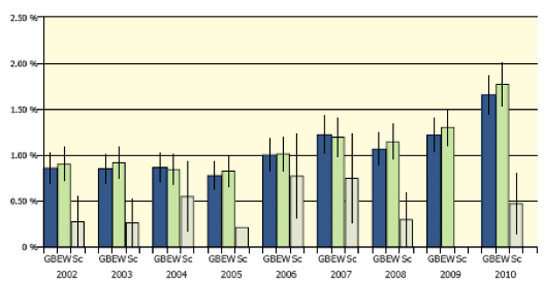
In the first and third quarters, S Mbandaka was identified as the predominant serotype, affecting mainly adult dairy cattle in the southwest of England. This serotype is associated with feeding ‘straights’ such as soya and rapeseed meal. The reason for the increase is unclear and would require further study to elucidate. The risk is two-fold: disease in cattle and disease in humans.
For cattle, the impact in terms of morbidity and mortality, for these salmonelloses is low. Currently, the number of incidents in cattle is also relatively low. There were 230 scanning surveillance diagnoses of salmonellosis caused by serotypes other than other than S. Typhimurium and S. Dublin in 2010. This is an increase from 99 incidents in 2005. However, a very small proportion of GB cattle are affected. The risk to public health from salmonella in cattle is believed to be low, because of low prevalence in cattle and measures to prevent contamination of the food chain.
The trend will be monitored through 2011 and, should it continue, will be investigated in order to determine the specific risk factors associated with S. Mbandaka.
Figure 6: Annual diagnoses of fasciolosis in GB, E&W & Scotland
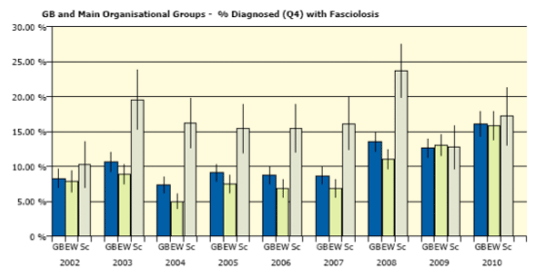
There was a significant rise in the percentage diagnosis of fasciolosis in GB for the fourth quarter compared to the same quarter in 2009.
The reason for this rise is not immediately apparent. There was a moderate forecast for fasciolosis for 2010 based on lower rainfall last spring and summer, which was 84per cent of the thirty-year average between 1971 and 2000 for England and Wales, and 69per cent for Scotland. Farmers may have been less inclined to incur the cost of treatment, based on the 20there was a forecast for significant disease.
The trend will continue to be monitored, but promotion of herd health plans, such as the VLA’s Herdsure for liver fluke, is the best, long term-means of controlling fasciolosis in dairy and beef herds.
Diarrhoea is a common disease in young beef and dairy calves. It is a cause of considerable economic loss, impairs welfare significantly and results in widespread use of, sometimes undesirable, antibiotic therapy.
Rotavirus infection and cryptosporidiosis are the two major infectious causes and both increased in England and Wales in 2010.
The proportion of diagnoses of rotavirus infection, although significantly greater in this quarter than the fourth quarter of 2009, is not dissimilar from that of previous years (Figure 7).
This is not the case for cryptosporidiosis (Figure 8), for which there were significantly more diagnoses in 2010 than in any of the preceding recent years. The cryptosporidiosis trend has been reported to industry levy-funded bodies in GB.
Figure 7: Annual diagnoses of rotavirus infection in GB, E&W & Scotland

Figure 8: Annual diagnoses of cryptosporidiosis in GB, E&W & Scotland

The actual numbers of diagnoses increased, as well as the proportion of samples tested yielding a diagnosis: cryptosporidiosis – 2009=1,278’ 2010=1,562; rotavirus - 2009=1,059, 2010=1,214.
The factors responsible for the observed increase in diagnoses of cryptosporidiosis are not fully understood.
Cryptosporidiosis is spread by the faeco-oral route, with persistence in the environment. Therefore factors associated with faecal hygiene of calf housing and pastures are likely to be involved. It could be beneficial to know whether failure to control cryptosporidiosis was due to lack of awareness of existing control measures, awareness but lack of implementation, or implementation but lack of efficacy. This could be an area for further research and has been suggested to industry bodies.
The VLA is currently undertaking some work on cryptosporidiosis:
- Farm-level studies on a small number of farms, with the intention of identifying the risk factors associated with the disease;
- Further work on the association between animal and human disease, to determine how much of the latter originates in animals.
As of the 1st of October 2010, serology has replaced microscopy as the primary diagnostic test for Johne’s disease. As serology has greater sensitivity, this could influence trends in scanning surveillance data on JD and changes from this date require appropriate interpretation. However, there was no significant change in the proportion of diagnostic submissions yielding a diagnosis of Johne’s disease for Q4 2010 (Figure 9).
Figure 9: Number of farms in GB in which Johne’s disease was diagnosed
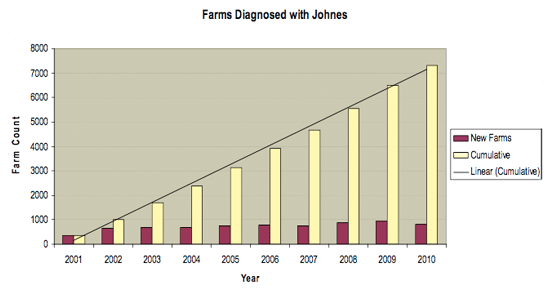
HORIZON-SCANNING
Economics of the beef cattle industry The June census for 2010 indicated a slight rise of 2.8per cent in the numbers of adult females in the national beef herd for England. In Wales there was a 2per cent rise in the number of non-dairy breeding female animals from 237,000 to 242,000.
This small increase in breeding females suggests that there will be a continued supply of beef cattle to market for 2011. The greatest threat to the beef industry in 2011 will be the rising price of commodities, such as concentrate and grain feed and fuel costs, which will probably continue during 2011. This will reduce the profit margin of beef farmers. Farmers may seek to make economies by reducing the involvement of their veterinary practices, which could adversely affect scanning surveillance.
Although the milk price has remained relatively stable, the price of several farm inputs has risen sharply: feed wheat costs nearly twice as much as 12 months ago, oil seed rape prices are very high and there is a shortage of reasonably priced good quality forage and straw.
It is likely that we see more effects of the above later in the winter of 2010/11, in particular if turn out is delayed. The higher input prices may adversely affect cash flow on dairy farms and hence may have a negative effect on the number of submissions. This effect may be partly off-set by an on-going shortage of dairy heifers: high stock prices encourage the investigation of disease.
A number of pharmaceutical companies are investing in genomics of cattle (including the genetic analysis of animal susceptibility to disease) to assess future breeding potential and suitability for artificial insemination. Genomic analysis provides information of these traits much sooner compared to, for example, assessing progeny performance for beef bulls used for artificial insemination.
Genomic analysis for disease susceptibility is at an advanced stage for feedlot-reared cattle in the United States. There is also growing interest from -beef producers in this country and evaluation of beef cattle genomics may have a significant effect on the health of beef cattle in GB.


